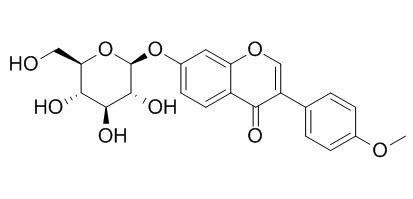Ononin
Ononin is an additional growth inhibitor in soils associated with the weed, Pluchea lanceolata, it can significantly inhibit root and shoot growth of mustard at 1×10(-4) M, 5×10(-4) M, and 1×10(-3)M , and inhibit the growth of pathogen such as Enterococcus sp., Enterobacter sp. and can promote the growth of probiotics such as Bifidobacteria sp. and Lactobacilli sp. Ononin has weak DPPH·free radical and the superoxide anion free radical scavenging capacity.
Inquire / Order:
manager@chemfaces.com
Technical Inquiries:
service@chemfaces.com
Tel:
+86-27-84237783
Fax:
+86-27-84254680
Address:
1 Building, No. 83, CheCheng Rd., Wuhan Economic and Technological Development Zone, Wuhan, Hubei 430056, PRC
Providing storage is as stated on the product vial and the vial is kept tightly sealed, the product can be stored for up to
24 months(2-8C).
Wherever possible, you should prepare and use solutions on the same day. However, if you need to make up stock solutions in advance, we recommend that you store the solution as aliquots in tightly sealed vials at -20C. Generally, these will be useable for up to two weeks. Before use, and prior to opening the vial we recommend that you allow your product to equilibrate to room temperature for at least 1 hour.
Need more advice on solubility, usage and handling? Please email to: service@chemfaces.com
The packaging of the product may have turned upside down during transportation, resulting in the natural compounds adhering to the neck or cap of the vial. take the vial out of its packaging and gently shake to let the compounds fall to the bottom of the vial. for liquid products, centrifuge at 200-500 RPM to gather the liquid at the bottom of the vial. try to avoid loss or contamination during handling.
Molecules.2019, 24(24),4583
Int J Mol Sci.2021, 22(21):11836.
Molecules2021, 26(1),230
Molecules.2020, 25(23):5636.
Mol Immunol. 2016, 78:121-132
The Korea Journal of Herbology2020, 35(3):33-45.
Sci Rep.2017, 7:46299
J Agric Food Chem.2024, 72(45):25219-25228.
J Chromatogr Sci.2015, 53(5):824-9
Int J Mol Sci.2023, 24(5):4505.
Related and Featured Products
Yao Xue Xue Bao. 2014 Aug;49(8):1162-8.
The interaction between ononin and human intestinal bacteria[Pubmed:
25322559]
METHODS AND RESULTS:
The study aims to screen the ability of the bacteria to metabolize Ononin and assess the effect of Ononin on the intestinal bacteria. Fresh human fecal sample was obtained from a healthy volunteer, diluted serially in sterile water and sixty-nine different bacterial colonies were picked out ultimately. UPLC-Q-TOF/MS with automated data analysis software (MetaboLynx) was applied to fast analysis of Ononin metabolites. Furthermore, an E(max) precision microplate reader was employed to determine the growth situation of Enterococcous sp., Enterobacter sp., Lactobacilli sp., and Bifidobacteria sp. Results indicated that hydrogenation, demethylation, hydroxylation and deglycosylation were the major metabolic pathways of Ononin by human intestinal bacteria in vitro. Ononin can inhibit the growth of pathogen such as Enterococcus sp., Enterobacter sp. and can promote the growth of probiotics such as Bifidobacteria sp. and Lactobacilli sp.
CONCLUSIONS:
This study suggested that intestinal bacteria have the metabolic effects of Ononin and the biotransformation was completed by different bacteria. And Ononin can affect the balance of intestinal flora and the degree of influence varies depending on the bacterial species and the concentration of Ononin.
J Chem Ecol. 1992 May;18(5):713-8.
Formononetin 7-O-glucoside (ononin), an additional growth inhibitor in soils associated with the weed,Pluchea lanceolata (DC) C.B. Clarke (Asteraceae).[Pubmed:
24253965 ]
Formononetin 7-O-glucoside (Ononin), an isoflavonoid, was isolated from the soils of cultivated areas associated with the perennial weed,Pluchea lanceolata. Aqueous solutions of this compound inhibited significantly root and shoot growth of mustard at 1×10(-4) M, 5×10(-4) M, and 1×10(-3)M. The level of inhibition was similar to that of hesperidin and taxifolin 3-arabinoside, as reported earlier. The potential allelopathic effect of this compound under field conditions is discussed.
J. Anhui Agricul. Universit., 2011, 38(2):151-5.
Free radical scavenging capacities of isoflavonoid glycosides isolated from Pueraria Radix.[Reference:
WebLink]
METHODS AND RESULTS:
Crude total isoflavonoids extracted from Pueraria Radix were partitioned by different organic solvents,then isolated and purified by several column chromatographic techniques and four isoflavonoid gly-cosides were obtained.On basis of the NMR and ESI-MS spectra,these four compounds can be identified as pu-erarin,daidzin,Ononin,and genistin,respectively.Using an organic free radical system of 1,1-diphenyl-2-picrylhydrazyl(DPPH·) and an inorganic free radical system of superoxide anion free radical,the free radical scavenging capacities and antioxidant activities of these four isoflavonoid glycosides were examined in vitro.The results showed that all the four isoflavonoid glycosides were discovered to possess the scavenging capacities of the DPPH·free radical and superoxide anion radical.Meanwhile,there was a significantly positive correlation between the two free radical scavenging capacities and the treated concentrations of the four isoflavonoid gly-cosides.Genistin showed the highest DPPH·free radical scavenging capacity,followed by daidzin and puerarin,and Ononin was the lowest among them.
CONCLUSIONS:
However,the superoxide anion free radical scavenging capacities of the four isoflavonoid glycosides were different from the former.Puerarin was discovered to be the strongest among them,followed by daidzin,genistin and Ononin.
China Pharmacy, 2010(47):4422-4.
Effect of 7 Kinds of Active Constituents from Astragalus membranaceus on the Expression of HIF-1[Reference:
WebLink]
To explore the effect of formononetin,Ononin,calycosin-O-β-D-glucoside,calycosin,acetylastragalosideⅠ,astragalosideⅡ, astragaloside Ⅳ from Astragalus membranaceus on the expression of hypoxia-induced factor-1(HIF-1).
METHODS AND RESULTS:
The HRE, derived from EPO containing a highly conserved HIF-1 binding site, were cloned into pBI-GL vectors that contained luciferase reporter genes. The HEK-293T cells were transfected cDNA constructs by calcium phosphate precipitation methods. The activity of luciferase was determined after 48 h treatment. The expression of HIF-1 was evaluated using luciferase report gene system. 10 μmol·L-1 formononetin promote expression of HIF-1.Ononin had an effect on the expression of HIF-1 in a concentration-dependent manner. Low concentration could elevate the expression of HIF-1 while high concentration down-regulated the expression. Other 5 monomers had no obvious effect on the expression of HIF-1.
CONCLUSIONS:
The study provide reference for the anti-tumor effect of A. membranaceus and therapeutic effect of it for other disease.



